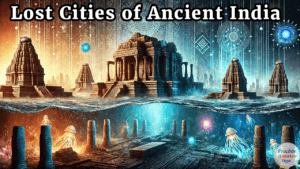
Lost Cities of Ancient India
In India, a land of ancient civilizations, stories of flourishing cities that once stood as beacons of human achievement, only to be lost in the sands of time, are held within its embrace. Among these, the legendary city of **Dwaraka**, linked to Lord Krishna, and the archaeological marvel of **Harappa**, a testament to the ingenuity of the Indus Valley Civilization, are spoken of.
” Dwaraka: The Mythical City Beneath the Waves “
In Hindu mythology, Dwaraka, often referred to as the city of Lord Krishna, is believed to have been located along the coast of Gujarat. According to the Mahabharata and other ancient texts, Krishna built the magnificent city of Dwaraka after fleeing Mathura to protect his people. The city was described as a golden city adorned with palaces, sprawling gardens, and a sophisticated layout
Modern exploration has lent weight to the legend. In the 1980s, marine archaeologists discovered submerged structures off the coast of present-day Dwarka. These underwater ruins showcased well-planned streets, rectangular stone blocks, and evidence of advanced harbor systems, which matched descriptions from ancient texts. Carbon dating of artifacts from the site suggested they belonged to a period that aligns with the Mahabharata era, around 1500 BCE.
Rising sea levels or tectonic activities are attributed to the submersion of Dwaraka, and its rediscovery is bridging the gap between mythology and history, opening new avenues of exploration into India’s rich past. This historic event has led to a deeper understanding of the ancient city’s fate and significance.
” Harappa: The Cradle of the Indus Valley Civilization “
While Dwaraka is shrouded in myth and mystery, Harappa is seen as a concrete example of ancient urban planning and sophistication. Located in present-day Pakistan, Harappa was one of the major urban centers of the Indus Valley Civilization, which flourished around 2600–1900 BCE. The Indus Valley Civilization was a highly advanced society, with impressive architectural and technological achievements.
Excavations at Harappa revealed a city ahead of its time, with meticulously planned streets, advanced drainage systems, and standardized brickwork. The city’s granaries, warehouses, and trade networks highlight its role as a significant economic hub. Harappa’s artifacts, including seals with inscriptions, pottery, and figurines, suggest a society deeply rooted in art, culture, and administration.
The sudden decline of Harappa is surrounded by one of the mysteries. It is hypothesized by scholars that the civilization’s downfall was led to by climate change, shifts in the course of the Sarasvati River, and possible invasions.
Table of Contents
” Linking the Ancient Threads “
India’s deep past is showcased by both Dwaraka and Harappa, with distinct yet interconnected aspects of its heritage being highlighted. While awe is inspired by Dwaraka with its blend of myth and reality, Harappa stands as a testament to the engineering and cultural achievements of early civilizations. India’s legacy as a cradle of human civilization is highlighted by them together.
Exploring these lost cities not only enriches our understanding of the past but also underscores the timeless wisdom and ingenuity of ancient India. As researchers make new discoveries, they continuously remind us of how temporary human accomplishments are and the ongoing desire to establish a connection with our origins.
Considering all this,
We are beckoned by the lost cities of ancient India to delve deeper into the mysteries of the past. Whether we explore the legends of Dwaraka or examine the tangible remains of Harappa, these cities narrate stories of glory, resilience, and eventual decline. They do not simply represent relics of history; rather, they symbolize a civilization that laid the foundation for much of what defines India today.
Lost Cities of Ancient India Lost Cities of Ancient India Lost Cities of Ancient India Lost Cities of Ancient India
